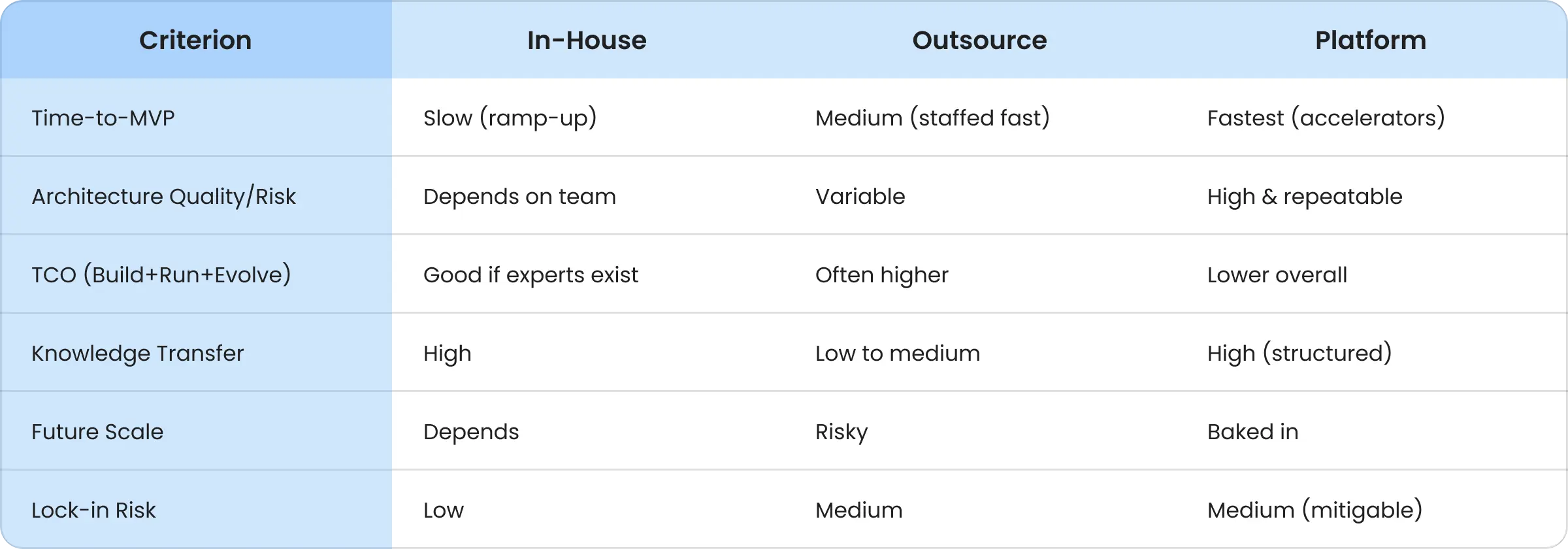When you’re, as a company or system integrator, looking to implement an IoT solution, you usually face three options: build it in-house, fully outsource, or co-build it with a platform team (like the one behind ThingsBoard).
Building in-house works well if you already have senior IoT architects and a long project runway. Outsourcing, on the other hand, may be suitable for a quick, low-stakes PoC. But for most companies, the most balanced choice is partnering with a platform team.
If time-to-value, reliability, and future scalability are your top priorities, a platform team gives you the shortest path to an MVP, reduces overall risk, and ensures real knowledge transfer instead of leaving you with a “black box” solution. In short, it’s the most direct way to get from architecture to results.
One solution – 3 delivery models. What do they mean?
In-House Development
This model works best for companies that already have experienced IoT architects and engineers on staff, and can afford a long runway of 12–18 months.
Pros: You get full control over the architecture and code, clear cost visibility, and retain direct intellectual property ownership.
Pitfalls: IoT projects demand expertise across multiple domains — from device connectivity and over-the-air (OTA) updates to security, rule chains, and performance scaling. Without prior IoT experience, your team can hit a talent bottleneck. The learning curve alone may take 3–12 months, turning the initiative into a slow and risky process.
Traditional Outsourcing
A solid choice if you need a quick demo, a narrowly scoped solution, or a project without a long-term roadmap.
Pros: Rapid access to engineers and flexible resourcing without lengthy hiring processes.
Pitfalls: The expertise of a third-party vendor in your specific IoT domain can vary wildly. Their business model often skews toward selling developer hours, not finishing a project faster. As a result, what looks like an attractive hourly rate can hide a much higher Total Cost of Ownership (TCO) due to rework, missed requirements, and costly fixes. They also often rebuild common plumbing from scratch, which wastes both time and budget.
Working with a Platform Team
For anyone who needs acceleration of IoT project, with built-in security and an eye toward future requirements, collaborating with an IoT development service by platform is the most balanced choice. This means working directly with the team that built and lives in the platform.
Pros: Deep platform knowledge ensures optimal implementation choices from day one, leading to predictable architecture and a shorter time to market. Engagements follow proven accelerators and patterns, with structured knowledge transfer to your team.
Pitfalls: Some companies worry about “vendor lock-in,” but this risk is mitigated by open APIs and documented extension points. While day rates may appear higher, the overall TCO is typically lower thanks to reduced delivery time and minimized risk of costly rewrites.

How to choose your path: a decision framework
Deciding on the right development model isn’t about guesswork, it’s about a structured evaluation of what matters most to your business. The most effective way to do this is by creating a scorecard. Review the following criteria and assess each model (in-house, outsourcing, or platform team) against the priorities of your project.
How critical is it to launch a minimum viable product quickly? A predictable delivery schedule often outweighs the appeal of a lower hourly rate.
Look beyond the initial build cost. Factor in long-term expenses such as infrastructure, licenses, support, training, and maintenance. A low upfront investment can mask a much higher long-term cost.
Will the IoT solution be easy to maintain and extend? Does it align with your long-term product roadmap?
What are your throughput goals? How many devices and messages per second must be supported? Will the solution meet your p95/p99 latency requirements?
Are there strict requirements for data residency, auditability, and access control (RBAC)? This is a non-negotiable for many industries.
Do you already have senior IoT architects and engineers with IoT related topics (scaling, security, OTA, etc.) expertise in-house? If not, building from scratch poses a significant talent risk.
How important is it for you to own every line of code? Assess the portability of the solution and whether its APIs are open and well-documented.
Who will run and maintain the solution in 3, 5, or even 10 years? What’s the plan if a core engineer leaves the team?
How easily will the solution connect with your existing systems, such as ERP/CRM, data lakes, or streaming services like Kafka?
If your project’s success depends on time-to-value, built-in security, and future scalability, the scorecard will almost always favor the Platform Team. It’s the path that delivers production-grade results quickly while protecting your long-term architectural integrity.
The economics: comparing rates vs. total cost of ownership
When weighing development models, it’s tempting to focus on one metric: the hourly rate. An outsourced team might advertise a lower rate, but that figure is often misleading. In practice, you may be paying for engineers who are learning your domain on the job and reinventing “plumbing” that others have already solved. The result? Longer timelines and significant hidden costs increase the total cost of ownership (TCO).
Platform teams, by contrast, may come with a higher hourly rate, but their economics work differently. They rely on mature templates, proven accelerators, and established architectural patterns that compress delivery time and minimize rework. In one internal benchmark for a warehouse monitoring project, the platform team delivered a production-grade solution 5–9x faster and cheaper than alternative approaches.
The bottom line is simple: don’t optimize for hourly/daily rates. Instead, focus on the total cost of ownership. The goal is a production-ready MVP delivered in weeks, with clear extensibility and defined Service Level Objectives (SLOs). A platform team’s model is designed to achieve these results with maximum efficiency, making it the more cost-effective choice in the long run.
KPIs that prove it worked
How do you know you made the right choice? It’s not about opinions – it’s about measurable results. The true proof of success lies in KPIs that reflect both technical excellence and business value.
Here are the metrics that matter:
- Lead time to first device online – days from project start to the first device sending data. A short lead time proves setup efficiency.
- Time to MVP – weeks to deliver a production-ready solution with defined critical flows. The ultimate speed benchmark.
- Throughput & latency – performance under load, measured by target messages per second and p95 latency.
- Uptime & reliability – track uptime against SLOs and monitor Mean Time to Repair (MTTR). This defines operational resilience.
- Cost per connected device – a clear view of long-term economics, including build costs and ongoing operations.
- Development efficiency – percentage of flows built with reusable rule-chain blocks. Shows how well the platform accelerates delivery.
- Integration reliability – success rate of ERP/CRM integrations, retry depth, and dead-letter messages. Proof that data flows are consistent and lossless.
The takeaway: Tracking these KPIs gives you a data-driven view of success. They prove that making strong architectural choices translates directly into faster delivery, lower costs, and more reliable IoT operations.
A mini case study: pattern, not hype
Talking about frameworks and KPIs is useful — but seeing them in action is better. Here’s a real-world example that shows how a platform-based approach delivers results.
Context
A large-scale warehouse monitoring project with tens of thousands of sensors. The requirement: track environmental parameters in real time and trigger instant alerts when thresholds were exceeded.
Approach
The team used ThingsBoard Professional Edition as the foundation.
- MQTT handled device data ingestion.
- Cassandra ensured efficient hot data storage.
- A proven “ingest→validate→enrich→route→DLQ” rule-chain template cut down implementation time.
- Kafka bridge enabled smooth integration with an existing data lake.
OTA updates kept firmware management under control.
Outcome
The impact of the collaboration was immediately noticeable:
- MVP delivered in 6 weeks — far ahead of industry averages.
- p95 alert time under 10 seconds, even at scale.
- Operator dashboards were live from day one.
Adding new warehouses required only minimal effort.
(Note: Metrics are based on an internal reference project. Actual results will depend on scope and constraints.)
The takeaway: This isn’t hype – it’s a repeatable pattern. By combining a proven platform with a team that knows it inside out, you skip months of groundwork and move straight to production-grade results: faster launches, lower risk, and scalable architecture.
Risks & mitigations: be honest about the challenges
Every IoT project carries risks. Success depends not on pretending they don’t exist, but on recognizing them early and putting mitigation strategies in place. Here are the most common challenges and how to manage them effectively:
1. Scope Creep
Projects can easily expand beyond their original intent.
Mitigation: use time-boxed epics, a formal change control process, and a transparent backlog with clear business acceptance criteria. This discipline keeps the focus on what matters most.
2. Performance Surprises
Discovering too late that your system can’t handle the load is costly.
Mitigation: start with a capacity model (devices, messages/sec, payload size). Run load tests early and configure autoscaling based on live metrics like queue depth.
3. Vendor Lock-in
A valid concern with platform-based approaches.
Mitigation: secure IP ownership in your contract, keep all code in your repositories, and rely on platforms with open APIs, documented extension points, and a clear exit plan.
4. Security Gaps
Security isn’t a “nice-to-have”, it’s foundational.
Mitigation: apply threat modeling and least-privilege access. Rotate credentials periodically and ensure all changes are logged and auditable.
5. Knowledge Loss
A solution is only sustainable if your team can own it long-term.
Mitigation: make enablement part of the deliverables. Use pair programming, recorded code reviews, and living architecture documentation. Ensure your team leaves with the runbooks and knowledge to operate the system independently.
Rules of thumb: when each model fits
Ultimately, the best choice depends on your specific situation. There’s no one-size-fits-all answer, but you can use these simple rules of thumb to guide your decision:
Go In-House
When you already have senior IoT architects, proven platform expertise, and a generous project runway of 12–18 months.
Go Outsourcing
For a short-lived Proof of Concept (PoC) with a narrow scope and no long-term roadmap—ideally with a vendor who has already solved something very similar in your niche.
Go Platform Team
When you need production-grade results fast, expect your backlog to evolve, and want your internal team to be enabled and empowered—not sidelined.
By following these guidelines, you can match your development model with your business goals and set your project up for success from the very beginning.
In conclusion
There is no “one-size-fits-all” solution for every IoT project. The right choice depends on your specific needs, resources, and long-term goals. If you have deep, in-house IoT expertise and plenty of time, building it yourself is a great option. If all you need is a quick demo or a short-lived proof of concept, outsourcing can get the job done.
But for the majority of businesses, where production results, time-to-value, and future scalability are non-negotiable, the most balanced choice is to work with a platform’s IoT development company. This approach not only gets you to market faster with a reliable, scalable solution, but it also empowers your own team with the knowledge they need to own the solution for the long haul. It’s an investment in a product and your people.




